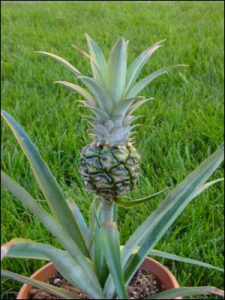By Brooke Moffis
Growing tropical and subtropical fruit such as, banana, pineapple, star fruit, and pomegranate is possible in Central Florida. The key to producing bumper crops of sweet, succulent fruit is knowing the plant’s preferred site and growing conditions, timing, and cold protection methods.

Selecting the right plant for the right site is crucial to the long-term success of your garden and landscape. Most tropical and subtropical fruit crops require at least six to eight hours of full sun. If fruit crops are planted in too much shade they will experience reduced flowering and fruiting, and when fruit develops it will not be as large as those grown in the sun. Another consideration for plant selection involves soil moisture. Bananas, for example, prefer moderately moist soil and will not thrive in dry conditions. Whereas pomegranates and cassava prefer well-drained soils and cannot tolerate wet feet.
Timing is critical to ensure a crop reaches harvest and knowing the time to harvest encourages gardeners to be patient with their plants. For instance, papaya should be planted as soon as the danger of frost is over to harvest in the fall before January temperatures are upon us. Get a jump start on your papaya by starting seeds in the winter while protecting them and plant outside at the end of February.
It gave me peace of mind the first time I grew pineapple, knowing that it can take eighteen to thirty-six months to develop a fruit that is harvestable. This knowledge kept me from giving up on the plants and as a result, I tasted one of the best pineapples I ever had. Another plant that takes longer to harvest than most realize is the banana. It can take nine to twenty months to create a harvestable bunch. Look for banana varieties on the market with faster production time.

Cold Protection
While it’s hard to think of cold protection in the middle of summer when temperatures are in the 90’s, it is still an important consideration when planting and timing tropical food crops. One night of hard frost or freezing temperatures can set our tropical plants back and sometimes kill them. Several previous years of mild winter temperatures favor tropical fruit production. When freezing temperatures are predicted, place several pieces of PVC pipe or wooden stakes covered by cloth blankets around fruit trees to build a tent around it to trap heat from the ground.
For more information on growing tropical fruit go to the UF/IFAS Extension FruitScapes website at http://trec.ifas.ufl.edu/fruitscapes/.
 0
0
